
The 2019 Ford Ranger may technically be new, but it’s actually based on a platform that’s been around since 2011. Yet it’s still a rock-solid offering that makes up for its lack of soul with sheer competence in every area that matters to mid-size truck buyers.
(Full Disclosure: I asked Ford if I could borrow a new Ranger for a road trip, and also possibly for towing and off-roading, so the company dropped off a snazzy Lariat with the FX4 and Trailer Tow packages. I didn’t end up using the truck for towing or off-roading, but I did drive it over 1,200 miles.)
A few weeks ago, I had to get to a friend’s wedding in north-central Virginia, and since I hadn’t driven the new Ford Ranger for more than just a few minutes at the Jeep Gladiator press drive, I figured I’d see how The Blue Oval’s mid-size truck fared on a long stretch of highway and through beautiful twisty roads of rural Appalachia. I came away pleased, but perhaps not exactly excited. The Ford Ranger is a solid, but tame mid-size truck.
What Is It?
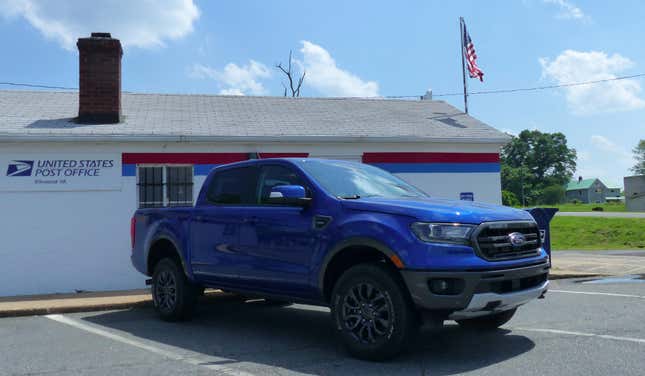
In some ways, the Ford Ranger might seem like a stop-gap pickup. Ford saw mid-size truck sales blossoming in the U.S., so it decided to quickly modify its nearly decade-old “T6” global Ranger for stateside use, presumably until it can design a new vehicle from the ground up. That’s why there’s already talk of the next-generation truck on the horizon, and that’s probably why there’s no Ford Ranger Raptor coming stateside (Right? It seems like it’s easy money.). This thing will be replaced in the not-too-distant future, I bet.
But that’s not to say that the 2019 Ranger is bad. Actually, it’s one of the most fuel efficient and torquey gas trucks in the segment, and its towing and payload numbers are thoroughly impressive. Part of that can be attributed to what is arguably the most modern powertrain in any mid-sizer: a 270 horsepower, 310 lb-ft 2.3-liter turbocharged inline-four, which sends power to a 10-speed automatic transmission and then to a leaf-sprung solid rear axle, and—if in 4x4—to independently sprung front wheels.
Styling wise—both inside and out—the Ranger looks a bit old. Handsome, but old, in a Kevin Costner-ish kind of way. And though Ford says the fully-boxed frame is new, this truck looks pretty much exactly like the T6 Ranger, especially after its 2016 refresh. So I can’t imagine the frame is that different. But antiquated bones aren’t really that big of a deal when it comes to body-on-frame trucks; what matters is capability, and on that front, the specs speak for themselves.
Specs That Matter
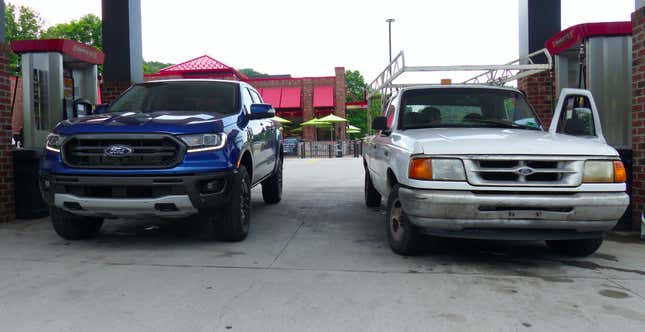
On paper, the Ford Ranger is a beast. It not only scores an EPA-rating of up to 26 MPG highway in two-wheel drive guise—matching or exceeding significantly less powerful four-cylinder variants of the Toyota Tacoma and Chevrolet Colorado—but it’s also rated to tow 7,500 pounds, and has a payload capacity as high as 1,860 pounds.
That payload figure is good, and the only other gas mid-size truck rated to tow as much is the Jeep Gladiator, and it can only reach its 7,650 figure in base Sport trim. The Ranger, on the other hand, will tow 7,500 in any trim—XL, XLT, or Lariat.

It helps that the Ranger has significantly more torque than any gas truck in the segment, besting the Gladiator by a whopping 50 lb-ft, the Colorado by 35 lb-ft, and smashing the Tacoma by 45 lb-ft. Also helpful is the truck’s reasonable (well, relatively) curb weight, with the SuperCrew 4x4 weighing 4,441 pounds, or about the same as a 4x4 Double Cab Tacoma and Crew Cab 4x4 Colorado, but significantly lighter than the heavyweight 4,672-plus pound Jeep Gladiator.
Speaking of size, the Ranger is huge by the standards of its predecessor. But in the mid-size truck world, it’s actually got some nice dimensions, with an overall length of 211 inches, a width of 73 inches (not including mirrors), and a height of roughly 71 inches. That makes it a tiny bit taller than the Tacoma and Colorado, but otherwise smaller than those and way smaller than the huge Gladiator.
So when it comes to the spec sheets, the Ranger’s got a lot going for it: good fuel economy, excellent towing and payload figures, lots of torque, relatively reasonable exterior dimensions, not too much heft, and on top of that, pretty impressive off-road specs.
What’s Good
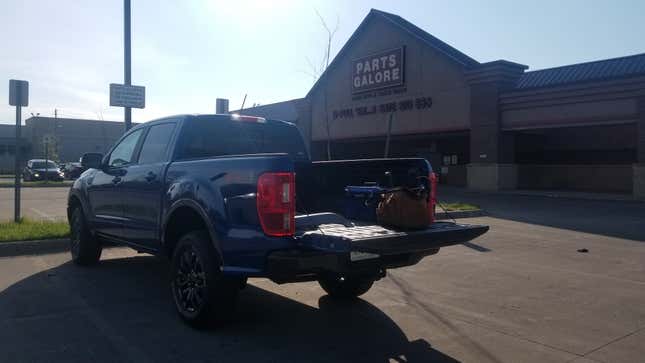
I can’t say I put many of those impressive specs to the test. I didn’t do any towing or off-roading, and the only payload I had in the bed was my socket set, my tool bag, and a few parts I snagged from a Detroit-area junkyard called Parts Galore. You won’t be surprised to hear that the truck handled that load just fine.
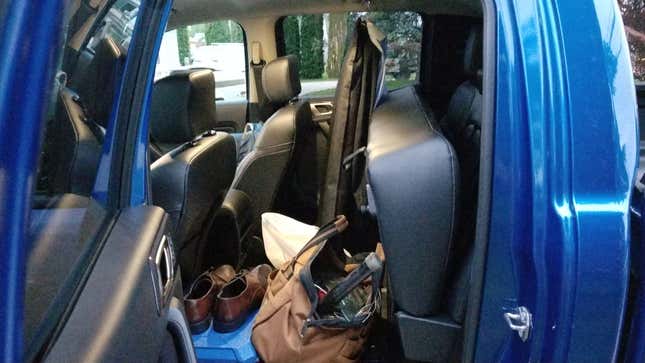
The fold-up back bench in my SuperCrew model also meant that, when it came time to pack for my trip to Virginia, the second row fit my tools, suit, and everything else I needed for this three-day excursion to see my old college buddy tie the knot.

I had to be in Virginia by 6 p.m. on Friday for the rehearsal dinner, so by 6 a.m., I had the truck loaded up, and I began cruising east. Unfortunately, I hadn’t gotten a whole lot of sleep the prior night, so I was expecting this to be a slog. And in any of my own personal cars, it would have been. But the seemingly endless interstate driving actually wasn’t too bad in the Ranger.

The seats felt comfortable, the lane-keeping system—activated via a stalk on the left side of the steering wheel—worked well enough to let me get a bit lazy with my hands, adaptive cruise control kept me a nice distance from the cars in front of me, and overall cabin noise was well-managed. On the highway, the ride quality didn’t seem any better than the solid axle Jeep Gladiator I’d driven a few months prior, but it was decent, and the engine’s power was more than enough to tackle even the steepest sections of the Pennsylvania turnpike without having to spin up high in the rev range.
Overall, the Ranger is a good highway cruiser.
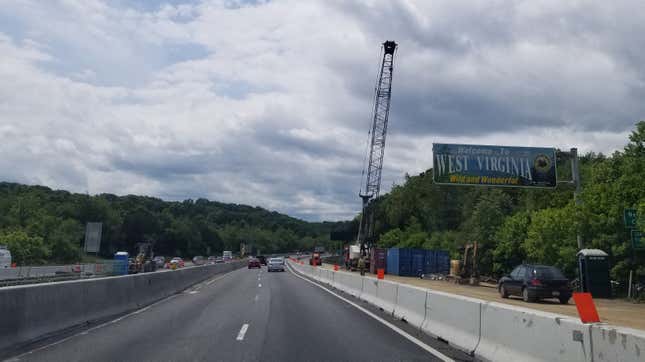
I arrived at the rehearsal dinner at at 5 p.m., after 11 straight hours on the road, and actually felt energetic enough to socialize with a group of total strangers—a tall task for anyone who’d just been on the road for so long, especially an engineer (we’re not known for our social skills).
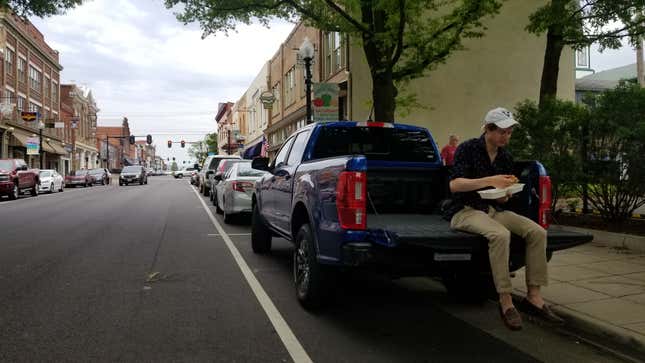
After a great meal in which I chatted away with what felt like a crowd full of only graduates of my alma mater, UVA, I drove from the rehearsal dinner to my hotel, and the following morning, my college buddies and I hung out in the historic downtown area of Culpeper. We ate at a farmer’s market, and then, to kill time, the group decided to do the most UVA (read: preppy) thing possible: We drove to a vineyard.
It was actually quite nice, and though I didn’t drink any wine, the vineyard did make for a good backdrop for some Ranger photos, which highlight the vehicle’s simple, but still pleasing sheetmetal and fascias:

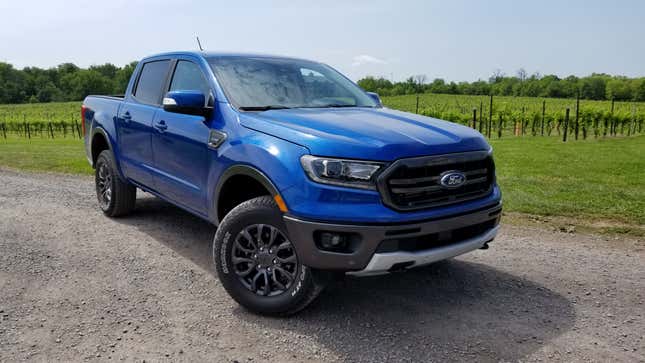
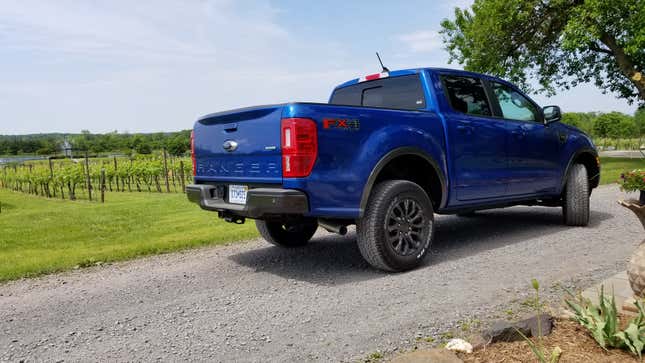
The following day, I didn’t touch the Ranger. I just took a shuttle to the stunningly beautiful wedding, where I attempted to act as sophisticated as possible, only to blow my cover when I asked the people at my table what the heck Cotillion was (It’s an etiquette class, which I guess is common in Virginia? Anyway, that’s where the bride, in her excellent and romantic speech, said she’d first met the groom).

After the wedding, I drove towards Charlottesville to meet my brother—an engineering Ph.D. student at UVA—at my go-to barbecue place, and it was on the way there that I confirmed what I’d felt two days prior as I drove down twisty roads on my way to the vineyard: The Ranger is actually kind of fun in the turns, and that’s a lot more than I could say about the Gladiator I drove earlier in the spring.
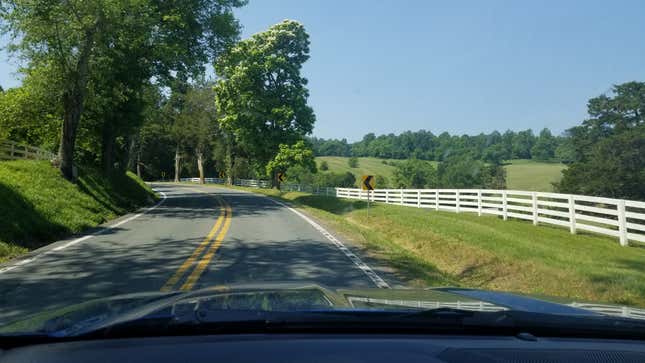
The 2.3-liter EcoBoost hooked up to the 10-speed transmission is a downright quick combination, accelerating the truck surprisingly purposefully and producing a sound that’s actually somewhat sporty—at least, more so than the naturally aspirated V6s that populate this segment.
That engine and transmission combination acts as an excellent propellant for back-road buffoonery, which is made possible by the vehicle’s sharp steering. Crank the wheel, and the Ranger’s nose—which sits nice and low relative to my seating position, allowing for excellent forward visibility—darts almost immediately into a turn.
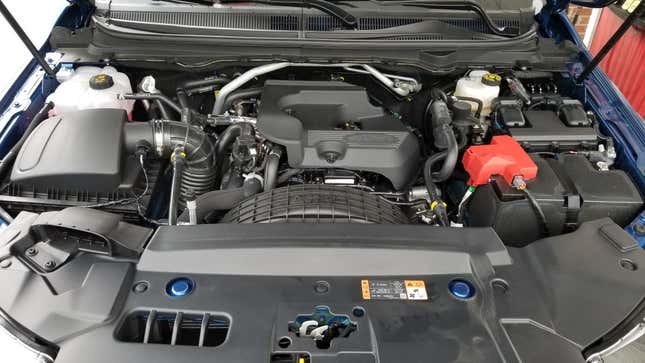
The Ranger’s rack-and-pinion steering setup, and its front suspension design, mean that the lag that you feel between “steering wheel turn” and “vehicle turn” in a truck like the solid-front-axle Jeep Gladiator just isn’t nearly as prominent. In the Jeep truck, I turn the wheel, and it feels like the chassis eventually turns, and then drags the cabin along with it. In the Ranger, it feels like the steering wheel, the chassis, and the cabin all turn together tightly with very little body roll, and just a general behavior that made driving on twisty roads not just more enjoyable, but also less stressful.
Obviously, the Ranger has huge wheels and tires, a two-ton-plus curb weight, and a leaf sprung solid axle, so it’s not a sports car. But, at least compared to the last Gladiator I drove, it sure feels like one.
What’s Weak

As much as I liked the Ranger’s powertrain, I will say that there were times when it didn’t feel particularly responsive to hard pedal inputs. Particularly when I was cruising at a steady speed in a high gear, if I slammed the pedal to the floorboard, it felt as if the engine and trans went on a picnic before finally giving me the acceleration I desired. Okay, maybe “went on a picnic” is a bit harsh, because it wasn’t terrible lag, but it was enough for me to notice.
I also noticed some strangely cheap plastics. I myself am far from a stickler when it comes to this kind of thing, but this is a pickup truck, and we all know that part of the American dream is driving a truck with the windows down and your arm hanging out of the window. Why, then, is the door panel trim on which the driver’s arm would rest made of such hard plastic?
There’s a stitched dashboard, and yet the tops of the door panels are hard. I don’t get that.
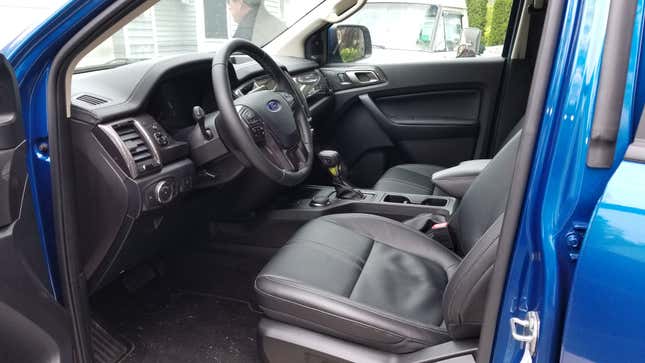
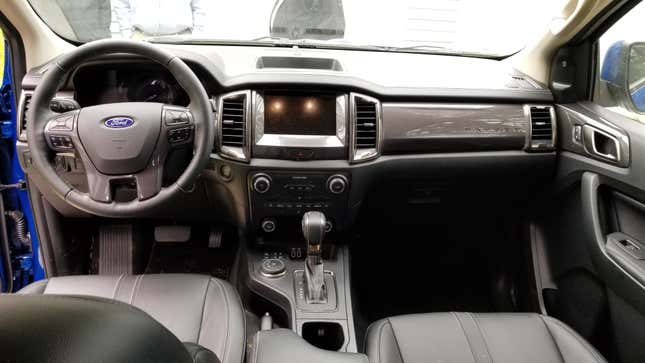
Speaking of cheap plastics, the keypad on the door is laughable to the point that a number of people pointed out how bad it looked. I don’t have a good photo to show it, but the gaps between the Fisher-Price-quality plastic and the curved sheetmetal almost makes it look like the plastic is totally flat on the bottom instead of being designed to conform to the curve.
I understand that some folks are huge fans of the keypad, but on a $45,000-ish truck, this just needs to be better integrated (perhaps make it a thin, flat pad in the dark, B-pillar part of the front door?). As it stands, it looks like an afterthought.
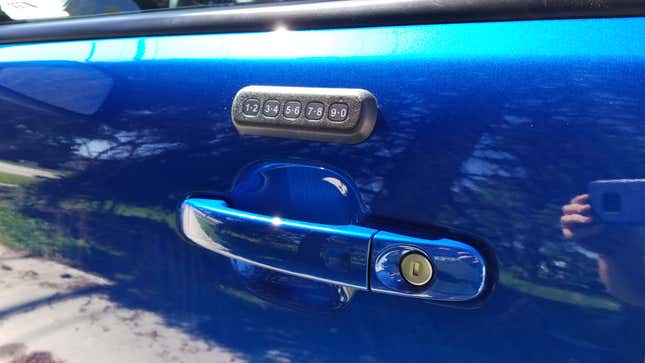
I also noticed that I was filling up fairly frequently. Yes, the truck was doing about 23.5 MPG cruising at 75 MPH on the highway according to the readout in the gauge cluster, and that’s actually not bad for the segment. But what would be nice is if that additional fuel economy translated into additional range, because the Ranger has a tiny 18-gallon fuel tank. That is over three gallons smaller than the tank in the Tacoma, Gladiator, and Colorado, and 1.5 gallons smaller than the Pilot-based Honda Ridgeline.
It just seems a bit silly that a 22 MPG combined 4x4 Ranger has to fuel up just as frequently as a 19 MPG 4x4 Chevy Colorado ZR2. This, admittedly, isn’t a huge deal, but when towing 7,500 pounds, I bet the fill-up frequency would be ridiculous.
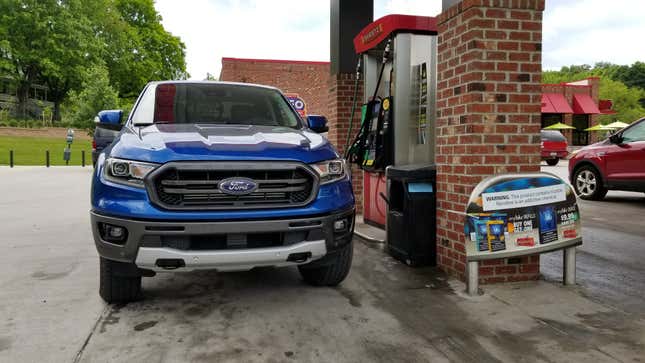
Aside from the small fuel tank, the minor lag in acceleration, and some wacky hard plastics, my biggest complaint is the truck’s lack of soul. I think the styling is handsome, but a bit too plain, and I bet that has to do with the fact that I’d already seen this look before overseas. The interior, too, is basically the same as what’s been available elsewhere for years, and to me that really detracts from the truck’s allure. Perhaps more time with the truck, especially off-road or towing, would give it more character in my eyes.
Verdict
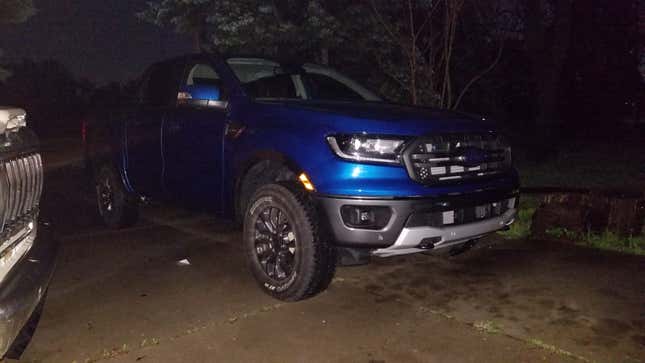
Upon returning home from Virginia at around 2 a.m. on Sunday, I snapped the photo above and went inside to sleep. I didn’t do the “look back” that I normally do when a car has captured my imagination, and my dreams that night did not feature a blue mid-size truck from FoMoCo.
All that is to say that I didn’t fall in love with the Ranger, as it didn’t stick out as something truly special. But a lot of that has to do with styling, because from a performance standpoint, I have to give the truck tremendous credit. It rides and handles well; it’s got a great engine that accelerates the truck with purpose; its dimensions mean it’s actually decently maneuverable; it offers good visibility; its fuel economy is impressive for the segment; and its towing, payload, and off-road specs are rock-solid.
The 2019 Ford Ranger does a lot right, but car buying is an emotional decision, so you’ll have to decide for yourself if it stirs your soul enough for you to drop all that cash.